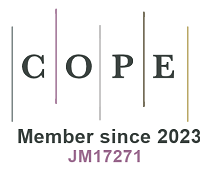Black microplastic in plastic pollution: undetected and underestimated?
Abstract
Plastic pollution includes microplastics. The environmental ubiquity of microplastics (< 5 mm) is evident and the leak of microplastics into the environment is projected to increase globally. Microplastics in the environment possess high heterogeneity in polymer composition, particle size, shapes, and surface chemistry, which sometimes result in contradictory toxicological findings. However, much less attention is paid to the color of microplastics, particularly black plastics that are the least recycled and account for a significant proportion of total plastic waste and environmental microplastics. In the present perspective article, based on 50 field-based research articles on microplastics published from 2014 to 2022 and our own research experience, we raised specific environmental concerns about black microplastics and emphasized the challenges posed by black microplastics in multiple aspects. Future prospects were also discussed for better mitigating black microplastics in the context of plastic pollution.
Keywords
Plastics bring convenience and create economic growth in today’s world but also cause environmental pollution. In a recent OECD (Organisation for Economic Co-operation and Development) report in 2022, plastics use is projected to nearly triple, from 460 Mt in 2019 to 1231 Mt in 2060. The use in transportation, construction, and packaging constitutes 60% of total plastic use. The widespread use, inappropriate waste management, and low recycling efficiency result in a significant leak of plastics into natural environments. It becomes clear that the continuous degradation and fragmentation can generate small plastic fragments, called microplastics (< 5 mm), that are widely distributed in different environments and organisms[1]. Environmental microplastics can also originate from the leak of primary plastics manufactured of that size. It is estimated that there will be 5 Mt of microplastics in lakes, rivers, and oceans in 2060, even with increasing proper management[2].
In addition to their ubiquity and increasing amount in the environment, global concerns are also growing about the unclear ecological and health impacts of microplastics. Microplastics can be ingested by aquatic and terrestrial organisms across all trophic levels, inducing detrimental biological effects like gut blockage, growth inhibition, and behavior changes via different molecular and cellular mechanisms[3,4]. More recent studies also detected microplastics in human lung tissues[5] and blood samples[6], providing human health implications. Furthermore, microplastics can act as carriers for bacteria, pathogens, and organic pollutants, etc. due to their large surface area and surface chemical properties[7,8], which complicate the effects of microplastics.
Microplastic contamination is heterogeneous due to its high heterogeneity in polymer composition, particle size, shapes, colors, and surface chemistry of environmental microplastics. The character-dependent exposure and effects of microplastics have been increasingly acknowledged; however, less attention is paid to the color of microplastics. In aquatic environments, some studies have suggested that the color of microplastics affects the uptake by fish, and particles with colors resembling their prey were more often ingested[9,10]. Moreover, the radiative effects of airborne microplastics and associated implications for global climate are new topics, and black microplastics might contribute significantly due to their high effective radiative forcing[11]. Similar to microplastics of other colors, black microplastics include primary black particles < 5 mm designed for commercial use, such as cosmetics, as well as secondary black microplastics from the breakdown of larger black plastic items. Black plastics pose unique challenges in multiple aspects. There is a large amount of requirement for raw black plastic materials in many sectors, such as food packaging, cooking utensils, trays, toys, electronic household goods, automobile components, etc., which make up around 15% of the total domestic plastic waste[12] [Figure 1]. Also, due to the lack of inexpensive and efficient technologies for sorting, as well as the relatively low market value, the majority of black plastics end up in landfills, incinerators, rivers, and oceans after a single use[13]. Thus, the main purpose of the present paper is to obtain the current status of black microplastics in the environment, highlight remaining unknowns, and propose future directions for a better understanding of the issues of black microplastics. Based on state-of-the-art literature and our own analytical experience, we speculate that black microplastics are as ubiquitous as other microplastics in different environments, but in lower amounts than microplastics of white or other colors.
This perspective paper focused on the field-based research on microplastics published in recent years from 2014 to 2022. Keywords including “abundance”, “distribution”, “occurrence”, “characteristics”, and “microplastic” were used to search for peer-reviewed publications in the database of Web of Science. Laboratory studies using only standard microplastics or self-made microplastics were excluded. After screening, a total of 50 articles reporting the occurrence and abundance of microplastics in different environmental and biological matrices were identified and analyzed, including detection and measurement of microplastics in wastewater (2 papers), sewage sludge (1 paper), freshwater (15 papers), coastal water (13 papers), sediment (14 papers), soil (2 papers) and organism (3 papers) samples [Table 1].
Black and white microplastics (MPs) detected in 50 studies.
| Article | Proportions of black MPs (%) | Proportions of white MPs (%) | Sample types | DOI |
| 1 | 4.85 | 22.33 | Wastewater | 10.1007/s11356-020-11411-w |
| 1 | 8.16 | 25.17 | Wastewater | 10.1007/s11356-020-11411-w |
| 2 | 15.1 | 14.2 | Wastewater | 10.1016/j.scitotenv.2020.141026 |
| 3 | 17.6 | 59.6 | Sewage sludge | 10.1016/j.watres.2018.05.034 |
| 4 | 1 | 2 | Freshwater | 10.1016/j.marpolbul.2020.111956 |
| 5 | 0.9 | 27.3 | Freshwater | 10.1016/j.scitotenv.2020.143503 |
| 6 | 20 | 25 | Freshwater | 10.1016/j.scitotenv.2021.146700 |
| 7 | 49 | Not reported | Freshwater | 10.1016/j.scitotenv.2020.143111 |
| 8 | 6.2 | 8.7 | Freshwater | 10.1016/j.marpolbul.2014.06.032 |
| 8 | 2.9 | 10.3 | Freshwater | 10.1016/j.marpolbul.2014.06.032 |
| 9 | 3.9-10.4 | 7-56.5 | Freshwater | 10.1016/j.scitotenv.2020.138560 |
| 10 | 56.46 | Not reported | Freshwater | 10.1016/j.marpolbul.2019.110569 |
| 11 | 3.3 | Not reported | Freshwater | 10.1016/j.marpolbul.2020.111383 |
| 12 | 73 | 1.2 | Freshwater | 10.1016/j.marpolbul.2018.01.030 |
| 13 | 18.2 | Not reported | Freshwater | 10.1016/j.marpolbul.2018.06.020 |
| 14 | 3.3 | 73.8 | Freshwater | 10.1016/j.marpolbul.2020.111383 |
| 15 | 14.6 | 41.3 | Freshwater | 10.1016/j.scitotenv.2021.145591 |
| 16 | 55.5 | 14.4 | Freshwater | 10.1016/j.marpolbul.2020.111516 |
| 17 | 28.4 | Not reported | Freshwater | 10.1007/s10653-021-00872-8 |
| 18 | 11 | Not reported | Freshwater | 10.1016/j.envpol.2020.116348 |
| 19 | 6.4 | 57.4 | Coastal water | 10.1016/j.scitotenv.2018.09.244 |
| 20 | 13.5 | 70.5 | Coastal water | 10.1016/j.marpolbul.2019.04.023 |
| 21 | 7 | 31 | Coastal water | 10.1021/acs.est.9b06400 |
| 22 | 11.5 | 3.8 | Coastal water | 10.1016/j.marpolbul.2017.03.002 |
| 22 | 0.9 | Not reported | Coastal water | 10.1016/j.marpolbul.2017.03.002 |
| 22 | 7.6 | 29 | Coastal water | 10.1016/j.marpolbul.2017.03.002 |
| 23 | 3 | 58 | Coastal water | 10.1016/j.marpolbul.2020.111343 |
| 24 | 13.5 | 70.5 | Coastal water | 10.1016/j.marpolbul.2019.04.023 |
| 25 | 8 | Dominant | Coastal water | 10.1016/j.marpolbul.2016.12.052 |
| 26 | 19.55 | 45.42 | Coastal water | 10.1016/j.marpolbul.2020.111655 |
| 27 | 3 | 58 | Coastal water | 10.1016/j.marpolbul.2020.111343 |
| 28 | 2.7 | 71.9 | Coastal water | 10.1016/j.marpolbul.2020.110922 |
| 29 | 6.4 | 57.4 | Coastal water | 10.1016/j.scitotenv.2018.09.244 |
| 30 | 0.7 | 33.8 | Coastal water | 10.1016/j.envpol.2020.114125 |
| 31 | 71.44 | 7.66 | Coastal water | 10.1016/j.ecss.2020.106757 |
| 31 | 21.56 | 17.65 | Sediment | 10.1016/j.ecss.2020.106757 |
| 32 | 0.62 | 49.3 | Sediment | 10.1016/j.scitotenv.2020.144777 |
| 33 | 19 | 42 | Sediment | 10.1016/j.marpolbul.2021.112264 |
| 34 | 8 | 26 | Sediment | 10.1016/j.marpolbul.2021.112550 |
| 35 | 11.7 | 26.8 | Sediment | 10.1016/j.scitotenv.2018.06.327 |
| 36 | 7.3 | 71.8 | Sediment | 10.1016/j.marpolbul.2016.11.009 |
| 37 | 16 | 42 | Sediment | 10.1016/j.envpol.2016.12.064 |
| 38 | 5 | 19 | Sediment | 10.1016/j.marpolbul.2016.07.022 |
| 39 | 32 | 18 | Sediment | 10.1016/j.scitotenv.2021.146700 |
| 40 | 12.6 | 10 | Sediment | 10.1016/j.scitotenv.2021.146969 |
| 41 | 15.3 | 22.25 | Sediment | 10.1016/j.marpolbul.2016.09.018 |
| 42 | 16 | 4 | Sediment | 10.1016/j.envpol.2016.12.064 |
| 43 | 12 | 16 | Sediment | 10.1038/s41598-017-11079-2 |
| 7 | 47 | Not reported | Sediment | 10.1016/j.scitotenv.2020.143111 |
| 44 | 24.9 | Not reported | Sediment | 10.1016/j.gr.2022.01.019 |
| 45 | 1 | 2 | Sediment | 10.1016/j.marpolbul.2020.111956 |
| 46 | 43.7 | Not reported | Organism | 10.1111/gcb.14519 |
| 46 | 31.3 | Not reported | Organism | 10.1111/gcb.14519 |
| 46 | 39.1 | Not reported | Organism | 10.1111/gcb.14519 |
| 47 | 26.4 | 0.7 | Organism | 10.1038/s41598-018-37428-3 |
| 48 | 53.56 | 27.21 | Organism | 10.1016/j.chemosphere.2020.129479 |
| 48 | 54.17 | 28.57 | Organism | 10.1016/j.chemosphere.2020.129479 |
| 49 | 4.94 | 32.1 | Soil | 10.1038/s41598-018-36172-y |
| 50 | 39.39 | Not reported | Soil | 10.1016/j.envpol.2018.07.051 |
The overall results showed that microplastics were detected in all environmental and biological matrices sampled, and that aquatic environments/organisms account for the majority. The most commonly reported information included the occurrence (surface water, aquatic sediments, beaches, lands, and organisms), abundance (number or mass concentrations), chemical compositions (e.g., PE, PS, PP, PVC, and PET), as well as characteristics of microplastics, including their shapes (e.g., fragment, fiber, film, foam, pellet, and irregular shape), colors (e.g., white, black, blue, green, and red), and particle sizes.
Black microplastics were found in all the 50 peer-reviewed articles, varying extensively from 0.62 to 71.44 % of the total amount of microplastics detected in different studies. Most papers (45/50) reported that black microplastics accounted for less than 30% of total microplastic abundance; over half of the total 50 papers showed that black microplastics only accounted for 0%-15% of the total microplastic abundance [Figure 2]. Overall, the average detection rate or frequency of black microplastics tended to be lower than that of white microplastics. We proposed multiple possible explanations for the low proportion of black microplastics in the environment. Firstly, the black color is often achieved by adding 0.5 to 3 mass percent soot or black master batch in the polymer melt during the extrusion process[14]. As black microplastics exhibit very low reflectance of light under the detecting sensors, such as traditional near-infrared (NIR) sensors, resulting in a low signal-to-noise ratio that is insufficient for identification, meanwhile the black chemical additives can change the spectra dramatically, resulting in high complications of identification[14]. Also, compared with white and other colors, it is more likely to overlook black microplastics when screening, extracting, separating, and identifying microplastics visually or under optical and fluorescence microscopy, which may lead to an underestimated amount and proportion of black microplastics in the total environmental microplastics.
Figure 2. The proportions of black and white microplastic abundance in total microplastics detected in the environmental and biological samples. Data source: Table 1.
Polymer chemical information is essential to track or predict the source and fate of microplastics in the environment. Surprisingly, although many studies have provided the total percentages of different polymers types (e.g., PE and PP being the dominant polymer types of microplastics in most studies), no article among the 50 articles reported the chemical composition based on the colors of microplastics. Thus, simple but fundamental questions, such as what polymer types of black microplastics are the most frequently detected, what polymer types of black microplastics are the most abundant, and what the potential sources of black microplastics are, cannot be answered. Such knowledge gaps could be attributed to technological limitations in sorting and identifying black microplastics, low awareness of recording chemical confirmation of microplastics, and unharmonized protocols used among microplastic researchers.
Plastic pollution is of global environmental and health concern, but black plastic is particularly problematic. Black plastics are the most common plastics in many uses. Again, current technology methods used for plastic sorting cannot recognize black plastics[15], making black plastics difficult to recycle. Due to the lower recycling rate, larger amounts of black plastics are likely to end up as wastes in the environment, which may become bigger sources of total microplastics than white plastics over time. To enable environmental/health risk assessment and management of black microplastics, future research and developments are urgently needed to (1) reduce the production of black plastic products and ban single-use black plastic products like food containers and mulch; (2) develop new detectable and harmless black pigment; (3) switch to more sustainable alternatives and materials; (4) create new recycling systems incorporating novel segregation sorting methods[16]; (5) establish a comparable and harmonized sampling and analytical approach for quantification of environmental microplastics and nanoplastics; (6) establish a standard reporting dossier that contains complete information on microplastic characteristics, particular chemical information; (7) assess ecotoxicity and human health effects of black microplastics and chemical additives[17] (e.g., plasticizers, flame retardants, black dyes) released from black plastic products; (8) make collaborative efforts with managers, policymakers, industries, researchers, and the public to prevent and mitigate the leak of black plastics into the natural environment.
DECLARATIONS
AcknowledgmentsThis research was supported by the Department of Biology, University of Southern Denmark, and Danmarks Frie Forskningsfond. Y.H.was jointly funded by the University of Southern Denmark and the China Scholarship Council (CSC).
Authors’ contributionsInvestigation, writing - original draft, funding acquisition: Huang Y
Conceptualization, writing - review & editing, supervision, project administration, funding acquisition: Xu EG
Availability of data and materialsNot applicable.
Financial support and sponsorshipNone.
Conflicts of interestBoth authors declared that there are no conflicts of interest.
Ethical approval and consent to participateNot applicable.
Consent for publicationNot applicable.
Copyright© The Author(s) 2022.
REFERENCES
1. Nguyen B, Claveau-Mallet D, Hernandez LM, Xu EG, Farner JM, Tufenkji N. Separation and analysis of microplastics and nanoplastics in complex environmental samples. Acc Chem Res 2019;52:858-66.
2. OECD (2022). Global plastics outlook. Policy scenarios to 2060. http://oecd.org/environment/plastics [Last accessed on 19 Aug 2022].
3. Chae Y, An YJ. Effects of micro- and nanoplastics on aquatic ecosystems: current research trends and perspectives. Mar Pollut Bull 2017;124:624-32.
4. Matthews S, Mai L, Jeong CB, Lee JS, Zeng EY, Xu EG. Key mechanisms of micro- and nanoplastic (MNP) toxicity across taxonomic groups. Comp Biochem Physiol C Toxicol Pharmacol 2021;247:109056.
5. Jenner LC, Rotchell JM, Bennett RT, Cowen M, Tentzeris V, Sadofsky LR. Detection of microplastics in human lung tissue using μFTIR spectroscopy. Sci Total Environ 2022;831:154907.
6. Leslie HA, van Velzen MJM, Brandsma SH, Vethaak AD, Garcia-Vallejo JJ, Lamoree MH. Discovery and quantification of plastic particle pollution in human blood. Environ Int 2022;163:107199.
7. Koelmans AA, Bakir A, Burton GA, Janssen CR. Microplastic as a vector for chemicals in the aquatic environment: critical review and model-supported reinterpretation of empirical studies. Environ Sci Technol 2016;50:3315-26.
8. Kinigopoulou V, Pashalidis I, Kalderis D, Anastopoulos I. Microplastics as carriers of inorganic and organic contaminants in the environment: a review of recent progress. J Mol Liq 2022;350:118580.
9. Ory NC, Gallardo C, Lenz M, Thiel M. Capture, swallowing, and egestion of microplastics by a planktivorous juvenile fish. Environ Pollut 2018;240:566-73.
10. Roch S, Friedrich C, Brinker A. Uptake routes of microplastics in fishes: practical and theoretical approaches to test existing theories. Sci Rep 2020;10:3896.
11. Revell LE, Kuma P, Le Ru EC, Somerville WRC, Gaw S. Direct radiative effects of airborne microplastics. Nature 2021;598:462-7.
12. Turner A. Black plastics: Linear and circular economies, hazardous additives and marine pollution. Environ Int 2018;117:308-18.
13. Ignatyev IA, Thielemans W, Vander Beke B. Recycling of polymers: a review. ChemSusChem 2014;7:1579-93.
14. Becker W, Sachsenheimer K, Klemenz M. Detection of black plastics in the middle infrared spectrum (MIR) using photon up-conversion technique for polymer recycling purposes. Polymers 2017;9:435.
15. Eisenreich N, Rohe T. Infrared spectroscopy in analysis of plastics recycling. In: Meyers RA, editor. Encyclopedia of analytical chemistry. Chichester: John Wiley & Sons, Ltd. 2006.
16. Bhuvanesh N, Kumaresan G, Rajasekaran S, Kiran Adish N, Saravanan K, Subramaniyan C. Experimental modelling and analysis of semi-automated waste black plastic materials sorter. Mater Today 2021;45:2029-33.
Cite This Article
How to Cite
Download Citation
Export Citation File:
Type of Import
Tips on Downloading Citation
Citation Manager File Format
Type of Import
Direct Import: When the Direct Import option is selected (the default state), a dialogue box will give you the option to Save or Open the downloaded citation data. Choosing Open will either launch your citation manager or give you a choice of applications with which to use the metadata. The Save option saves the file locally for later use.
Indirect Import: When the Indirect Import option is selected, the metadata is displayed and may be copied and pasted as needed.




















Comments
Comments must be written in English. Spam, offensive content, impersonation, and private information will not be permitted. If any comment is reported and identified as inappropriate content by OAE staff, the comment will be removed without notice. If you have any queries or need any help, please contact us at [email protected].